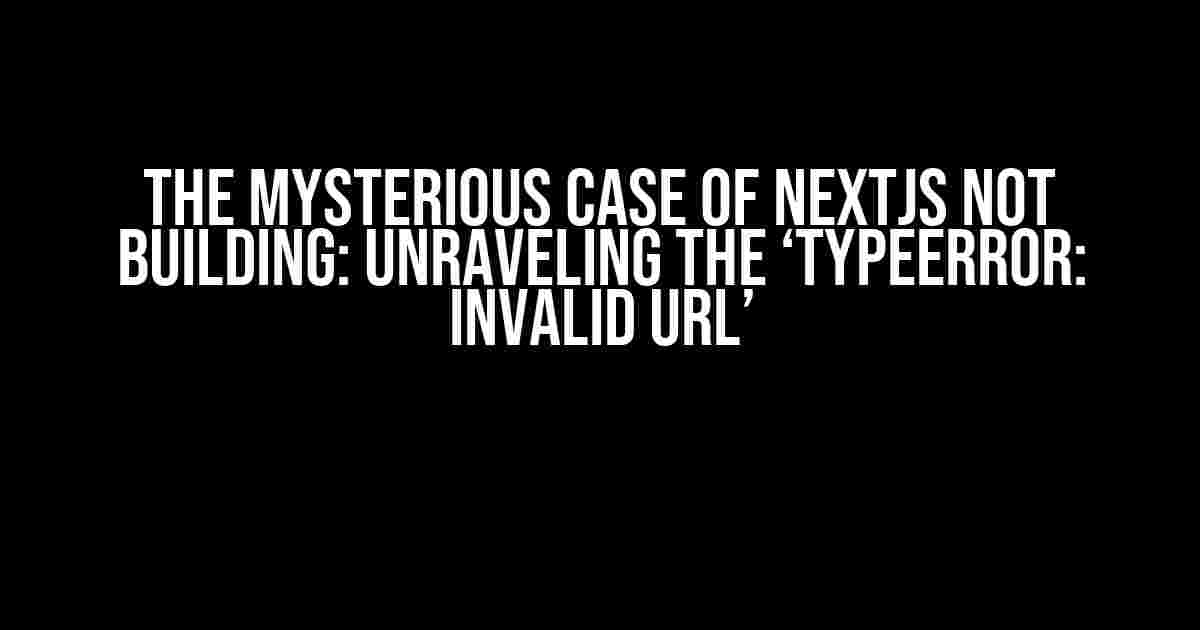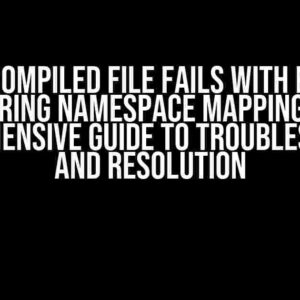Are you tired of staring at your terminal, wondering why NextJS refuses to build your application? You’re not alone! The frustrating ‘TypeError: Invalid URL’ error has struck many developers, leaving them scratching their heads. Fear not, dear reader, for today we’ll embark on a thrilling adventure to conquer this enigmatic issue and get your NextJS project building smoothly.
The Plot Thickens: Understanding the Error
Before we dive into the solution, let’s take a step back and examine the error message:
TypeError: Invalid URLThis cryptic message doesn’t reveal much, does it? Don’t worry; we’ll break it down together. The ‘Invalid URL’ error usually occurs when NextJS tries to process an invalid or malformed URL. This can happen due to various reasons, which we’ll explore in the following sections.
Suspect 1: Malformed URLs in getStaticProps
One common culprit behind the ‘Invalid URL’ error is malformed URLs in the `getStaticProps` method. This method is responsible for pre-rendering pages at build time. If you’re using relative URLs or invalid URL formats, NextJS will throw the ‘Invalid URL’ error.
Here’s an example of a malformed URL in `getStaticProps`:
export async function getStaticProps(context) {
const apiUrl = 'http://example.com/path///invalid-url';
const response = await fetch(apiUrl);
// ...
}In this example, the `apiUrl` has triple slashes (`///`) which is an invalid URL format. To fix this, ensure your URLs are properly formatted and absolute:
export async function getStaticProps(context) {
const apiUrl = 'https://example.com/path/valid-url';
const response = await fetch(apiUrl);
// ...
}Suspect 2: Incorrectly Configured Public Folder
The `public` folder in your NextJS project serves as a placeholder for static assets. If your `public` folder is not properly configured, NextJS might throw the ‘Invalid URL’ error.
Here’s an example of an incorrectly configured `public` folder:
// next.config.js
module.exports = {
// ...
asset: './public// assets', // Notice the double slash
// ...
}In this example, the `asset` path has a double slash, which is invalid. To fix this, ensure your `public` folder path is correctly configured:
// next.config.js
module.exports = {
// ...
asset: './public/assets', // Correct path
// ...
}Suspect 3: Misconfigured Plugin or Module
Sometimes, a misconfigured plugin or module can cause the ‘Invalid URL’ error. NextJS uses a variety of plugins and modules to enhance its functionality. If one of these plugins or modules is not configured correctly, it can lead to the error.
For example, if you’re using the `next-images` plugin, you might encounter the error if the plugin is not configured correctly:
// next.config.js
module.exports = {
// ...
images: {
domains: ['invalid://domain.com'], // Malformed URL
},
// ...
}In this example, the `domains` array contains an invalid URL. To fix this, ensure your plugin or module configurations are correct and properly formatted:
// next.config.js
module.exports = {
// ...
images: {
domains: ['https://example.com'], // Correct URL
},
// ...
}Investigation Complete: Solving the Mystery
Now that we’ve identified the suspects, let’s create a step-by-step guide to solve the ‘TypeError: Invalid URL’ mystery:
-
Check your `getStaticProps` method for malformed URLs. Ensure all URLs are absolute and properly formatted.
-
Verify your `public` folder configuration is correct. Ensure there are no double slashes or invalid paths.
-
Review your plugin and module configurations. Check for malformed URLs or incorrect formatting.
-
Inspect your `next.config.js` file for any typos or incorrect configurations.
-
Delete the `.next` folder and run `npm run build` again to rebuild your project.
By following these steps, you should be able to resolve the ‘TypeError: Invalid URL’ error and get your NextJS project building smoothly.
Bonus Tips: Avoiding Future Mysteries
To avoid encountering the ‘TypeError: Invalid URL’ error in the future, follow these best practices:
-
Use absolute URLs wherever possible.
-
Verify your `public` folder configuration is correct.
-
Double-check your plugin and module configurations for correctness.
-
Regularly inspect your `next.config.js` file for typos or incorrect configurations.
-
Delete the `.next` folder and run `npm run build` again when encountering unexpected errors.
By following these tips, you’ll be well-equipped to tackle any future mysteries that might arise in your NextJS project.
Conclusion: The Case is Closed
We’ve successfully solved the ‘TypeError: Invalid URL’ mystery and uncovered the root causes behind this enigmatic error. By understanding the suspects and following the step-by-step guide, you should be able to resolve the issue and get your NextJS project building smoothly.
Remember, debugging is an adventure, and with patience and persistence, you’ll conquer even the most puzzling errors. Happy coding!
| Keyword | Solution |
|---|---|
| NextJS not building, throwing ‘TypeError: Invalid URL’ | Check for malformed URLs in getStaticProps, public folder configuration, and plugin/module configurations. Delete the .next folder and run npm run build again. |
Feel free to share your own debugging adventures and tips in the comments below!
Frequently Asked Question
Stuck with NextJS and throwing a “TypeError: Invalid URL” error during build? Worry not, we’ve got you covered!
What’s causing the “TypeError: Invalid URL” error in NextJS?
This error typically occurs when NextJS is trying to access a URL that is not properly formatted or is invalid. This could be due to a misconfigured `getStaticProps` or `getServerSideProps` function, or even a faulty API call. Double-check your code and ensure that all URLs are correctly formatted and valid.
How do I troubleshoot the “TypeError: Invalid URL” error in NextJS?
To troubleshoot this error, try debugging your code by console logging the URL being accessed. You can also check the network requests in your browser’s dev tools to see if the request is being sent correctly. Additionally, review your `next.config.js` file to ensure that the `asset` or `public` paths are correctly configured.
Is there a way to catch and handle the “TypeError: Invalid URL” error in NextJS?
Yes, you can catch and handle this error by using a try-catch block around the code that’s throwing the error. You can also use NextJS’s built-in error handling mechanisms, such as the `ErrorComponent` or the `-error` API route, to handle errors in a centralized manner.
Can I ignore the “TypeError: Invalid URL” error in NextJS?
While it’s possible to ignore this error by using a `try-catch` block or other error-handling mechanisms, it’s not recommended as it may cause unexpected behavior or errors in your application. It’s always best to fix the root cause of the issue and ensure that your URLs are valid and correctly formatted.
What are some common scenarios that can cause the “TypeError: Invalid URL” error in NextJS?
Some common scenarios that can cause this error include incorrectly formatted URLs in your `getStaticProps` or `getServerSideProps` functions, faulty API calls, or even incorrectly configured `next.config.js` files. Additionally, issues with your `public` or `static` directories, or with your `asset` paths can also cause this error.



